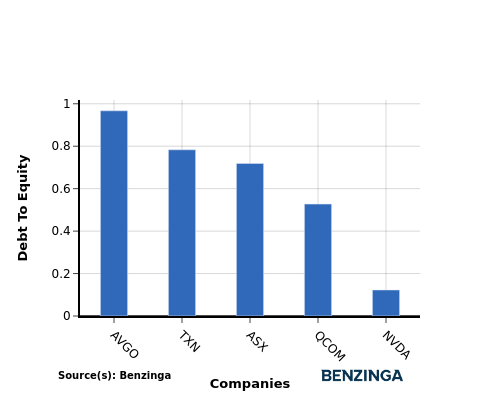Inquiry Into NVIDIA's Competitor Dynamics In Semiconductors & Semiconductor Equipment Industry
Amidst today's fast-paced and highly competitive business environment, it is crucial for investors and industry enthusiasts to conduct comprehensive company evaluations. In this article, we will delve into an extensive industry comparison, evaluating NVIDIA (NASDAQ:NVDA) in comparison to its major competitors within the Semiconductors & Semiconductor Equipment industry. By analyzing critical financial metrics, market position, and growth potential, our objective is to provide valuable insights for investors and offer a deeper understanding of company's performance in the industry.
NVIDIA Background
Nvidia is a leading developer of graphics processing units. Traditionally, GPUs were used to enhance the experience on computing platforms, most notably in gaming applications on PCs. GPU use cases have since emerged as important semiconductors used in artificial intelligence. Nvidia not only offers AI GPUs, but also a software platform, Cuda, used for AI model development and training. Nvidia is also expanding its data center networking solutions, helping to tie GPUs together to handle complex workloads.
| Company | P/E | P/B | P/S | ROE | EBITDA (in billions) | Gross Profit (in billions) | Revenue Growth |
|---|---|---|---|---|---|---|---|
| NVIDIA Corp | 52.93 | 47.72 | 27.32 | 23.01% | $22.58 | $26.67 | 69.18% |
| Broadcom Inc | 100.58 | 18.63 | 23.33 | 7.12% | $8.02 | $10.2 | 20.16% |
| Taiwan Semiconductor Manufacturing Co Ltd | 26.82 | 7.61 | 11.05 | 8.19% | $608.71 | $493.4 | 41.61% |
| Advanced Micro Devices Inc | 106.74 | 4.10 | 8.61 | 1.23% | $1.59 | $3.74 | 35.9% |
| Texas Instruments Inc | 41.68 | 12.19 | 12.60 | 7.08% | $1.85 | $2.31 | 11.14% |
| Qualcomm Inc | 15.74 | 6.11 | 4.10 | 10.3% | $3.67 | $6.04 | 16.93% |
| ARM Holdings PLC | 192.72 | 22.39 | 38.34 | 3.17% | $0.46 | $1.21 | 33.73% |
| Micron Technology Inc | 21.37 | 2.62 | 3.97 | 3.79% | $4.33 | $3.51 | 36.56% |
| Analog Devices Inc | 66.16 | 3.45 | 12.36 | 1.63% | $1.2 | $1.61 | 22.28% |
| Monolithic Power Systems Inc | 19.24 | 10.57 | 14.69 | 4.17% | $0.18 | $0.35 | 39.24% |
| STMicroelectronics NV | 26.94 | 1.60 | 2.42 | 0.32% | $0.51 | $0.84 | -27.36% |
| ON Semiconductor Corp | 41.02 | 3.07 | 3.80 | -5.78% | $-0.37 | $0.29 | -22.39% |
| ASE Technology Holding Co Ltd | 19.72 | 2.08 | 1.08 | 2.39% | $27.16 | $24.89 | 11.56% |
| United Microelectronics Corp | 11.68 | 1.40 | 2.29 | 2.06% | $23.86 | $15.45 | 5.91% |
| First Solar Inc | 13.67 | 2.11 | 4.06 | 2.59% | $0.35 | $0.34 | 6.35% |
| Credo Technology Group Holding Ltd | 340.34 | 24.86 | 40.94 | 5.63% | $0.04 | $0.11 | 179.73% |
| Skyworks Solutions Inc | 29.07 | 1.88 | 3.03 | 1.11% | $0.22 | $0.39 | -8.87% |
| Qorvo Inc | 150.83 | 2.39 | 2.25 | 0.93% | $0.11 | $0.37 | -7.6% |
| Lattice Semiconductor Corp | 143.54 | 10.32 | 15.02 | 0.71% | $0.02 | $0.08 | -14.68% |
| Universal Display Corp | 31.82 | 4.38 | 11.25 | 3.93% | $0.08 | $0.13 | 0.62% |
| Average | 73.67 | 7.46 | 11.33 | 3.19% | $35.89 | $29.75 | 20.04% |
By closely examining NVIDIA, we can identify the following trends:
-
The Price to Earnings ratio of 52.93 is 0.72x lower than the industry average, indicating potential undervaluation for the stock.
-
It could be trading at a premium in relation to its book value, as indicated by its Price to Book ratio of 47.72 which exceeds the industry average by 6.4x.
-
The stock's relatively high Price to Sales ratio of 27.32, surpassing the industry average by 2.41x, may indicate an aspect of overvaluation in terms of sales performance.
-
The Return on Equity (ROE) of 23.01% is 19.82% above the industry average, highlighting efficient use of equity to generate profits.
-
With lower Earnings Before Interest, Taxes, Depreciation, and Amortization (EBITDA) of $22.58 Billion, which is 0.63x below the industry average, the company may face lower profitability or financial challenges.
-
The gross profit of $26.67 Billion is 0.9x below that of its industry, suggesting potential lower revenue after accounting for production costs.
-
The company's revenue growth of 69.18% is notably higher compared to the industry average of 20.04%, showcasing exceptional sales performance and strong demand for its products or services.
Debt To Equity Ratio

The debt-to-equity (D/E) ratio gauges the extent to which a company has financed its operations through debt relative to equity.
Considering the debt-to-equity ratio in industry comparisons allows for a concise evaluation of a company's financial health and risk profile, aiding in informed decision-making.
By considering the Debt-to-Equity ratio, NVIDIA can be compared to its top 4 peers, leading to the following observations:
-
NVIDIA demonstrates a stronger financial position compared to its top 4 peers in the sector.
-
With a lower debt-to-equity ratio of 0.12, the company relies less on debt financing and maintains a healthier balance between debt and equity, which can be viewed positively by investors.
Key Takeaways
The low P/E ratio suggests that NVIDIA may be undervalued compared to its peers in the Semiconductors & Semiconductor Equipment industry. However, the high P/B and P/S ratios indicate that the market values the company's assets and sales more highly. On the other hand, the high ROE, revenue growth, and low EBITDA and gross profit ratios suggest that NVIDIA is generating strong returns on equity and experiencing significant revenue growth, despite lower profitability margins.
This article was generated by Benzinga's automated content engine and reviewed by an editor.
Posted-In: BZI-IANews Markets Trading Ideas



